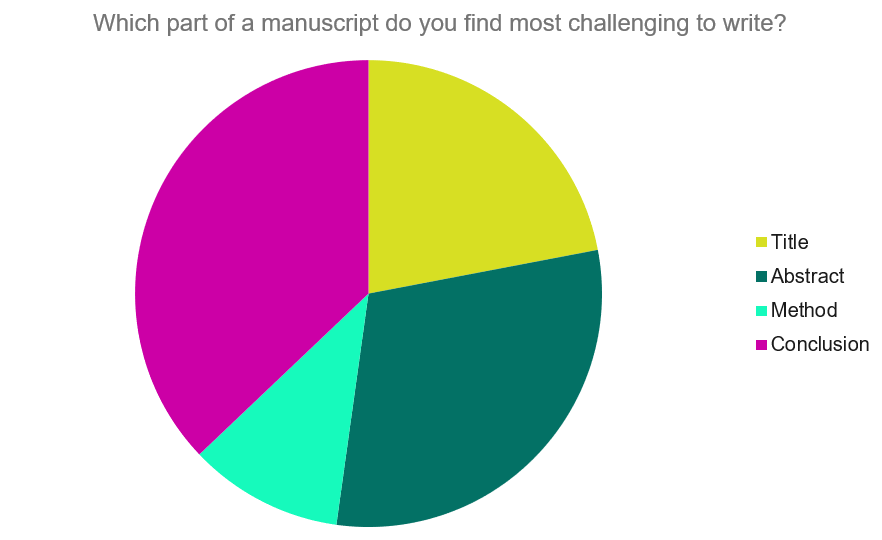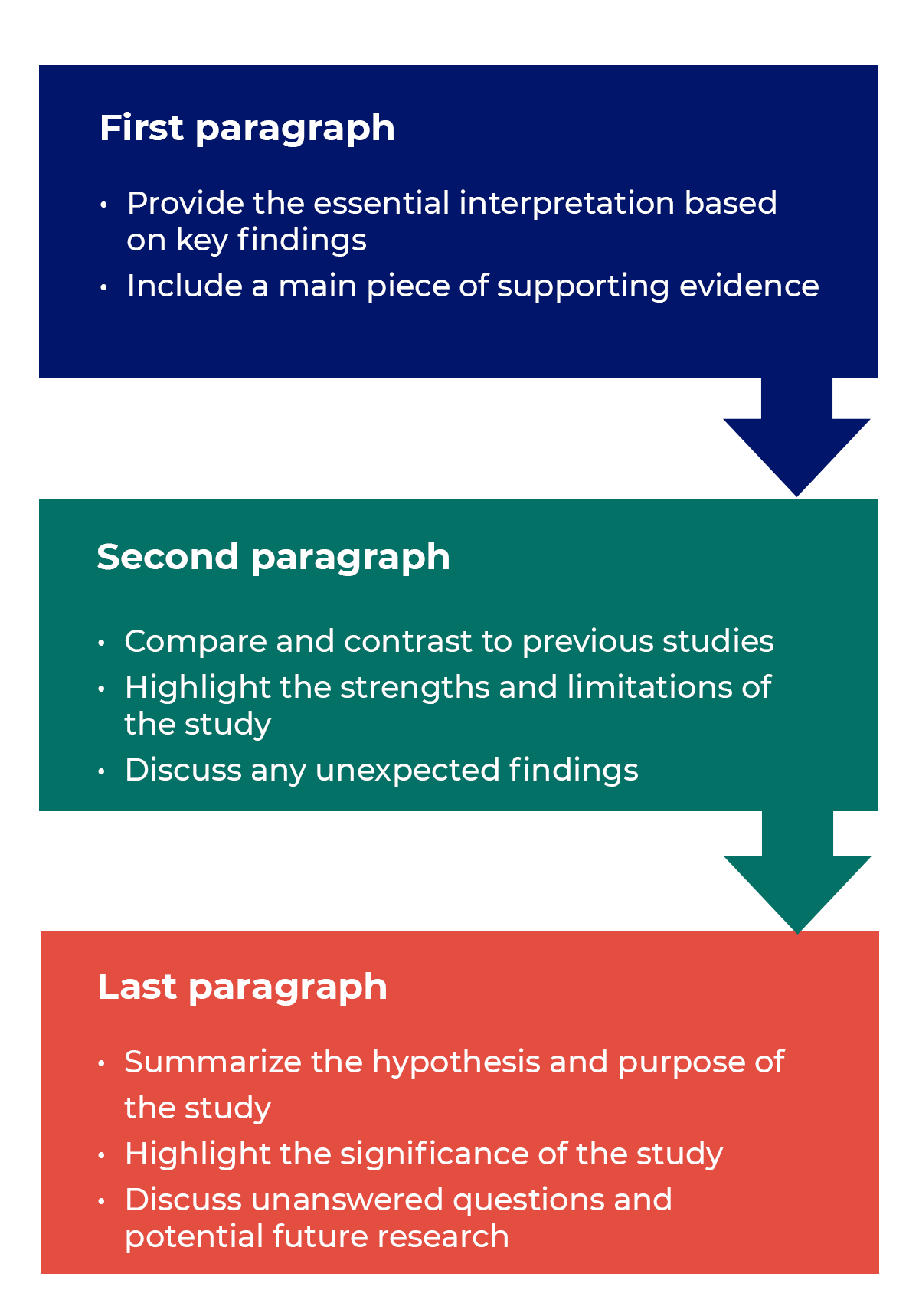Sample Apa Conclusion and Implications Section in a Literature Review
The word section contains the results and outcomes of a study. An effective give-and-take informs readers what tin can exist learned from your experiment and provides context for the results.
What makes an effective discussion?
When you lot're prepare to write your discussion, y'all've already introduced the purpose of your report and provided an in-depth description of the methodology. The discussion informs readers virtually the larger implications of your written report based on the results. Highlighting these implications while not overstating the findings tin be challenging, particularly when y'all're submitting to a periodical that selects manufactures based on novelty or potential impact. Regardless of what periodical you are submitting to, the discussion department always serves the same purpose: concluding what your study results actually mean.
A successful discussion department puts your findings in context. It should include:
- the results of your research,
- a discussion of related research, and
- a comparison between your results and initial hypothesis.
Tip: Not all journals share the same naming conventions.
You lot can utilise the advice in this article to the conclusion, results or discussion sections of your manuscript.
Our Early Career Researcher community tells us that the conclusion is frequently considered the most difficult aspect of a manuscript to write. To assistance, this guide provides questions to enquire yourself, a basic structure to model your give-and-take off of and examples from published manuscripts.

Questions to inquire yourself:
- Was my hypothesis right?
- If my hypothesis is partially correct or entirely unlike, what tin be learned from the results?
- How do the conclusions reshape or add onto the existing knowledge in the field? What does previous research say about the topic?
- Why are the results of import or relevant to your audience? Practise they add further prove to a scientific consensus or disprove prior studies?
- How tin future research build on these observations? What are the key experiments that must be done?
- What is the "take-domicile" bulletin you want your reader to exit with?
How to structure a discussion
Trying to fit a complete word into a single paragraph can add together unnecessary stress to the writing procedure. If possible, you'll want to give yourself two or iii paragraphs to give the reader a comprehensive understanding of your study as a whole. Hither's i way to structure an effective discussion:

Writing Tips
While the above sections can help yous brainstorm and construction your discussion, in that location are many common mistakes that writers revert to when having difficulties with their paper. Writing a discussion can be a delicate balance between summarizing your results, providing proper context for your research and avoiding introducing new data. Recall that your paper should be both confident and honest most the results!

Practise
- Read the journal'southward guidelines on the word and conclusion sections. If possible, learn about the guidelines before writing the discussion to ensure you're writing to meet their expectations.
- Begin with a articulate statement of the main findings. This will reinforce the main take-abroad for the reader and set up the rest of the discussion.
- Explain why the outcomes of your study are of import to the reader. Discuss the implications of your findings realistically based on previous literature, highlighting both the strengths and limitations of the inquiry.
- Country whether the results testify or disprove your hypothesis. If your hypothesis was disproved, what might exist the reasons?
- Introduce new or expanded ways to recall nigh the research question. Bespeak what next steps can be taken to further pursue any unresolved questions.
- If dealing with a contemporary or ongoing trouble, such equally climate change, hash out possible consequences if the problem is avoided.
- Be concise. Adding unnecessary item can distract from the chief findings.

Don't
- Rewrite your abstract. Statements with "we investigated" or "we studied" more often than not practice not belong in the word.
- Include new arguments or evidence not previously discussed. Necessary information and evidence should be introduced in the chief body of the paper.
- Apologize. Even if your research contains significant limitations, don't undermine your authorization by including statements that doubt your methodology or execution.
- Shy away from speaking on limitations or negative results. Including limitations and negative results volition give readers a complete understanding of the presented inquiry. Potential limitations include sources of potential bias, threats to internal or external validity, barriers to implementing an intervention and other issues inherent to the study design.
- Enlarge the importance of your findings. Making grand statements about how a study volition fully resolve large questions can lead readers to doubtfulness the success of the inquiry.
Snippets of Constructive Discussions:
- Summarize the cardinal findings in articulate and concise language
"The full general recommendations for deportment to reduce plastic pollution that emerged from the present study were: (1) refuse non-necessary plastic items, such as straws; (2) reduce dependence on traditionally unmarried-use plastic items (e.yard. shampoo bottles), for example past refilling or ownership larger bottles; (3) replace plastic items with reusable and/or alternative products with a lower surround impact; (iv) correctly dispose of items, such every bit wet wipes, that may be essential and this impossible to reject or reuse."Consumer-based actions to reduce plastic pollution in rivers: A multi-criteria decision analysis approach
- Acknowledge when a hypothesis may exist incorrect
"All reported cervix postures attained by live giraffes in the wild tin can exist replicated with the virtual skeleton range of motion without disarticulating the cervical vertebrae. Therefore, the cervical range of movement of extinct vertebrates should follow the same criteria until prove suggests otherwise. Hypothesis (ii) "some neck postures attained in life require disarticulating vertebrae", tin can be refuted." Ontogenetic similarities between giraffe and sauropod neck osteological mobility - Identify your study within the context of previous studies
"Our results, consistent with a number of studies of other species advise that trunk mass, rather than CIs (status indices), may exist one of the most useful measures for linking nutritional changes to population dynamics."Identifying reliable indicators of fettle in polar bears
- Talk over potential hereafter research
"Our results open an heady new avenue of study focused on laryngeal variation amongst further mammalian clades, which will provide the context required to decide how particular the differences we observe here are to the evolution of the primate larynx. If the relative flexibility of the primate larynx is robust to time to come analyses with more than clades, it would betoken an increased capacity to explore trait space in our lineage, which may in turn explain why primates have developed such diverse and complex uses of the vocal organ." Rapid evolution of the primate larynx? - Provide the reader with a "accept-abroad" statement to end the manuscript
"This further reinforces the notion that beyond being the apex predator of the latest Cretaceous Laurasian ecosystems, the tyrannosaurids were amongst the most achieved hunters amid large bodied theropods. We discover that their anatomy, at once efficient and elegant, notwithstanding besides capable of bursts of incredible violence and creature force, lives upwards to their monikers as the tyrant kings and queens, of the dinosaurs." The fast and the frugal: Divergent locomotory strategies bulldoze limb lengthening in theropod dinosaurs
Related Resource
-
How To How to Cull the Journal That's Right for Your Report
There's a lot to consider when deciding where to submit your work. Larn how to choose a journal that will help your study attain its audience, while reflecting your values equally a researcher…
Read more
-
How To How to Report Statistics
Ensure appropriateness and rigor, avoid flexibility and above all never manipulate results In many fields, a statistical analysis forms the center of…
Read more
-
How To How to Receive and Respond to Peer Review Feedback
A thoughtful, thorough approach to your revision response now tin can save you lot time in further rounds of review. You've simply spent months…
Read more
Source: https://plos.org/resource/how-to-write-conclusions/
0 Response to "Sample Apa Conclusion and Implications Section in a Literature Review"
Post a Comment